Резиме Abstract - Journal of Special Education and Rehabilitation
Резиме Abstract - Journal of Special Education and Rehabilitation
Резиме Abstract - Journal of Special Education and Rehabilitation
Create successful ePaper yourself
Turn your PDF publications into a flip-book with our unique Google optimized e-Paper software.
VIEWS-OPINIONS-DILEMMAS<br />
психо-социјалниот развој. Мерниот инструмент<br />
се покажал како валиден во истражувањата<br />
во дефектологијата, развојната психијатрија<br />
и невропсихологија. Добиените резултати<br />
даваат јасна слика дали детето има<br />
хиперактивно, инхибирано, дисхармонично<br />
или складно однесување (1).<br />
Основна цел на истражувањето беше<br />
утврдување на проблемите во однесувањето<br />
кај децата со лесна и умерена интелектуална<br />
попреченост.<br />
Посебни цели беа:<br />
- утврдување на видот на најзачестените<br />
проблеми во однесувањето кај испитаниците,<br />
односно кои облици на неприлагодено<br />
однесување се најфреквентно присутни и<br />
утврдување на влијанието на факторите<br />
(пол, возраст, интелектуален и социо-економски<br />
статус) кај оваа популација деца.<br />
Примерок<br />
Беа опфатени 100 испитаници на возраст од<br />
7 до 18 години, од кои 74 ученици со лесна<br />
интелектуална попреченост од ПOУ „Д-р<br />
Златан Сремац“ од Скопје (каде сите ученици<br />
се на дневна програма и повеќето живеат<br />
во своите семејства, освен одреден број<br />
деца кои живеат во дом за деца без родителска<br />
грижа) и 26 деца со умерена интелектуална<br />
попреченост од Заводот за рехабилитација<br />
на деца и младинци „Топанско поле“<br />
од Скопје (каде еден дел од децата се на<br />
дневна програма, додека другите се институционализирани).<br />
Истражувањето беше спроведено<br />
од април до јуни 2008 година. Започна<br />
со прибирање на релевантни податоци за<br />
испитаниците, а потоа беше реализирано<br />
скалирањето помеѓу дефектолозите кои се<br />
во интензивен контакт со испитаниците, но<br />
за да се намали субјективноста во процената,<br />
резулатите беа ревидирани од страна на членовите<br />
од стручните тимови (психолог, социјален<br />
работник).<br />
Резултати<br />
Основната цел беше испитана со помош на<br />
двете скали. Од табелата 1 на која е прикажан<br />
бројот на испитаници кои имаат проблеми<br />
во однесувањето според Скалата на<br />
ААМД, може да се забележи дека од вкуп-<br />
psychosocial development. The questionnaire<br />
has proved as valid in researches field <strong>of</strong><br />
special education <strong>and</strong> rehabilitation, developmental<br />
psychiatry <strong>and</strong> neuropsychology. The<br />
obtained results show whether the child has<br />
hyperactive, inhibited, disharmonic or harmonic<br />
behavior (1).<br />
The main aim <strong>of</strong> the research was to establish<br />
the behavioral problems in children with mild<br />
<strong>and</strong> moderate intellectual disability. The<br />
specific goals were:<br />
- establishing which behavioral problems are<br />
mostly frequent, or what kind <strong>of</strong> maladaptive<br />
behavior is most frequently expressed,<br />
- establishing the influence <strong>of</strong> the factors<br />
(gender, age, intellectual <strong>and</strong> social-economic<br />
status) on the behavior <strong>of</strong> these children.<br />
Sample<br />
The Sample consisted <strong>of</strong> 100 participants at the<br />
age between 7 <strong>and</strong> 18, out <strong>of</strong> which 74 were<br />
students with mild intellectual disability from<br />
the <strong>Special</strong> school “d-r Zlatan Sremec” from<br />
Skopje (where all students are on a daily<br />
program, mostly living within families, but also<br />
some students are parentless <strong>and</strong> live in<br />
orphanage) <strong>and</strong> 26 children with moderate<br />
intellectual disability from the Institute for<br />
<strong>Rehabilitation</strong> <strong>of</strong> Children <strong>and</strong> Youth “Topansko<br />
pole” – Skopje (where one part <strong>of</strong> the children<br />
are on a daily program, while others are<br />
institutionalized). The research was conducted<br />
from April till June 2008. It began with<br />
collecting general data about participants <strong>and</strong><br />
continued with scaling with the two Scales,<br />
among the special educators <strong>and</strong> rehabilitators<br />
who have intensive contact with the participants.<br />
In order to minimize the subjectivity <strong>of</strong><br />
the assessment, the results were reevaluated by<br />
pr<strong>of</strong>essional team members (psychologists,<br />
social workers).<br />
Results<br />
The main goal was examined by using the two<br />
Scales. In Table 1., which represents the number<br />
<strong>of</strong> participants that have behavior problems<br />
according to AAMD Scale it can be seen that<br />
52<br />
JOURNAL OF SPECIAL EDUCATION AND REHABILITATION 2009; 10(1-2): 49-62




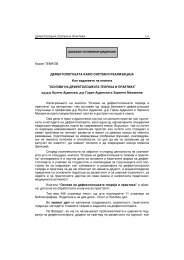
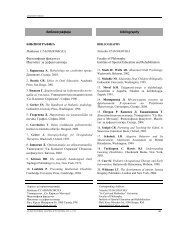
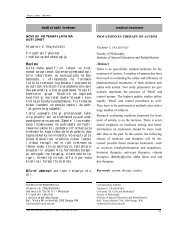
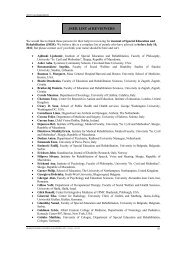
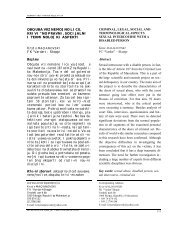
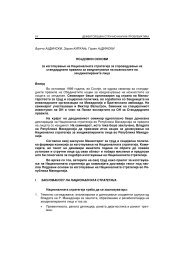
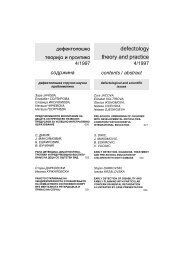
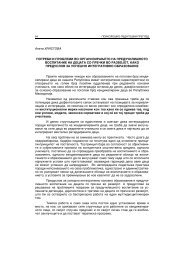
![b. apostoloski, m. ]aeva-pejkovska, s. nikolova, rana detekcija na ...](https://img.yumpu.com/32641898/1/184x260/b-apostoloski-m-aeva-pejkovska-s-nikolova-rana-detekcija-na-.jpg?quality=85)

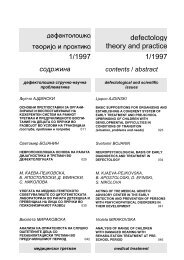
![45 Nada [IKI], Jelena IVI^EVI]-DESNICA AFAZIJA-EPILEPSIJA ...](https://img.yumpu.com/30952817/1/184x260/45-nada-iki-jelena-ivievi-desnica-afazija-epilepsija-.jpg?quality=85)
![120 Liljana KATI] Jagoda \OR\EVI] RAN TRETMAN NA EDEN ...](https://img.yumpu.com/29494618/1/184x260/120-liljana-kati-jagoda-orevi-ran-tretman-na-eden-.jpg?quality=85)